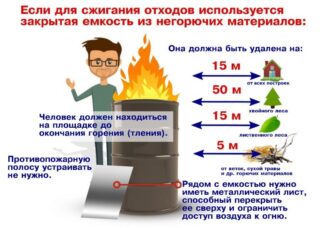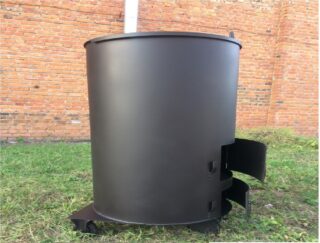
The most affordable way to dispose of garbage in the country is incineration. However, not all materials can be thrown into a fire. It is much safer to use a heat recovery furnace for a summer residence.
What can and cannot be burned
Garbage at the summer cottage is formed all year round. Dry leaves, unusable branches, plastic bottles and dishes after parties, construction waste, unnecessary rags, residues of detergents and household chemicals. It is prohibited to incinerate some of such waste, for example, containers with the remains of chemically aggressive substances. Others are allowed to burn, provided that certain requirements are met.
According to the laws adopted in 2005-2006 by many regions of the Russian Federation, it is prohibited to burn garbage, foliage and grass in a garden plot. This refers to burning at the stake.
A relatively safe method is to incinerate waste in a closed oven with a closed door. All other options are considered illegal.
Cannot be burned:
- plastic and rubber, all products made from them, since they emit a lot of toxic substances during combustion;
- electrical appliances - they must be transferred for recycling to recycling points;
- Particleboard and fiberboard - when burned, phenols and other harmful substances are released;
- objects made of metal and glass - so it is impossible to dispose of them;
- aerosol cans - explode when burned.
It is highly not recommended to burn items soaked in paints, varnishes, as well as items made of synthetic fibers in your oven.
Homemade or ready-made firebox
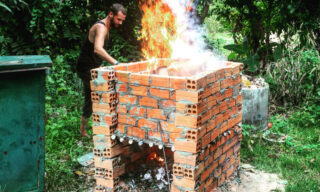
You can use both a purchased and a homemade design.
The undoubted plus of the first option is compliance with fire safety requirements. This is a closed furnace made of steel with a thickness of at least 3 mm, stable and sufficiently large. It is equipped with a high chimney, thanks to which the inhabitants of the dacha do not have to endure the smell of burning garbage. And also protected from the fallout of coals or the spread of sparks.
The disadvantage of the purchased product is the cost. The more durable the oven is, the more it costs.
A DIY waste incinerator is much cheaper. It is assembled from bricks, made of iron or suitable materials at hand, like a barrel, bucket. She most often refers to open models. On the websites of summer cottages, you can find drawings and detailed step-by-step instructions for making closed ovens, but their device is more complicated.
The fire hazard of open self-made options is noticeably higher, although models with covers prevent the spread of sparks. Worst of all is the lack of a chimney - it is impossible to get rid of the smoke.
Types of waste heat recovery furnaces
A do-it-yourself iron barrel incinerator is the most popular option. It is not difficult to get such a capacity, their wall thickness is sufficient, you can find any size. The work is not difficult.
Upright barrel stove
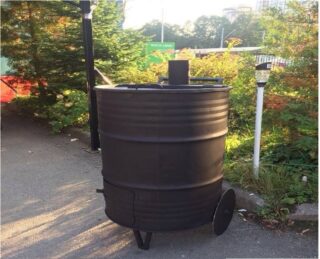
It is the easiest way to make a waste incinerator out of an iron barrel. The step-by-step manufacturing instructions are very simple.
- Remove the bottom with a grinder. Usually, it is no longer in old products.
- In the lower part, 2 holes are made from opposite sides - they provide traction.
- They dig a hole 1 m long and 30–40 cm deep - for 1 bayonet of a shovel.
- A small fire is made in the pit, and then a barrel is placed on top.
- Garbage is packed in batches and it is made sure that sparks do not fly out of the barrel.
- After incineration, the barrel is lifted and the resulting ash is used.
You can equip the oven in a barrel with a bottom or in a gas cylinder. In this case, holes for traction are drilled in the bottom, and the container itself is placed on brick supports.
Horizontal stove from a barrel with a pipe
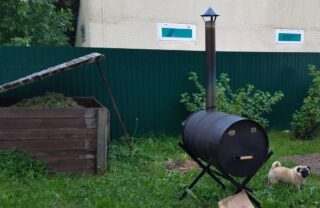
The chimney option is much more convenient, as it relieves the inhabitants of smoke and smell.
- A door is cut out in the bottom of the barrel. The incision is made, stepping back from the edge by 5-10 mm, the dimensions of the door are sufficient for placing garbage in the oven.
- The door is made from the same piece of iron by attaching a handle to it. They weld it onto the hinges.
- Goats are assembled from 5 pieces of a metal profile 1 m long. The pipes are connected crosswise in pairs. The fifth connects the crosses.
- Holes are made on the end sides of the barrels for traction.
- They make holes for the chimney: cut out a circle of the same diameter as the pipe, bend the "petals".
- The barrel is cleaned of rust with an emery nozzle, painted in several layers with heat-resistant paint. Then they put it on the trestle.
- The chimney is made of an iron pipe with a diameter of 10-15 cm and a length of 1-1.5 m. The pipe is bent at right angles.
- A grate made of reinforcing rods is welded inside the barrel. It provides air circulation, and ash accumulates in the space under it.
- The chimney is welded to the "petals". It is recommended to attach a spark arrestor funnel at its end.
This model is classified as closed and meets fire safety requirements.
Brick stove
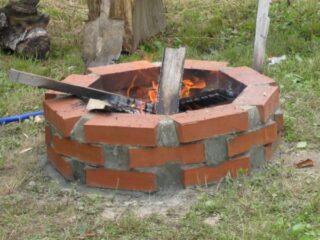
A brick oven is more difficult to construct. It requires refractory bricks, preferably red clay, and a special masonry mortar based on clay and sand. Its only difference from the usual one is the absence of a foundation.
- Choose a flat area. It is cleaned of debris and plant roots and covered with a 5 cm layer of sand.
- Bricks are placed around the perimeter with a gap of 1-1.5 cm.
- A tray for ash is installed on a brick - a metal sheet. It is advised to weld a handle to it so that the ash pan is easier to pull out and clean.
- The next row of bricks is laid with the same gap.
- A grid of reinforcing bars is placed on them - for incinerated garbage.
- Spread the next rows on the clay solution. The height depends on the estimated volume of debris.
- Cover the oven with a sheet of metal. When incinerated, the leaf is pushed back to release the smoke.
If you leave the incinerator without a lid, it will become an open model, which is unsafe to use.
Using an old sauna heater
A faulty heater is ideal for disposal. It is enough to free such a furnace from all elements, except for the grate, and reinforce its base with a steel sheet. A row of bricks with gaps is placed under the furnace to provide oxygen access. During garbage incineration, the firebox is covered with a metal sheet.
Safety measures and recommendations for incineration of garbage in ovens
- The stove is installed on a flat area of 10 m. The area is freed from dry grass, leaves, and wooden objects.
- A fire hazardous object can be placed no closer than 8 m to a brick house and 15 m to a wooden one.
- Deciduous trees and shrubs can be placed no closer than 15 m from the stove, conifers - no closer than 50 m. Needles contain less moisture than leaves and are much easier to catch fire.
- During strong winds, droughts, it is prohibited to burn garbage.
- Sand, fire extinguisher, tarpaulin are stirred near the incinerator to quickly extinguish the escaping flame.
- Do not leave a lit stove unattended.
Care should be taken to ensure that children and pets do not go near the incinerator when it is running.
Alternative disposal options
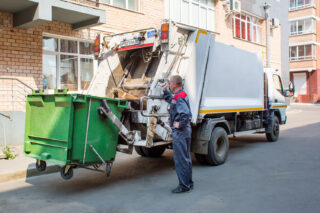
Other disposal methods can be used.
- The most sensible method is garbage collection by special services, but it is available only in settlements with developed infrastructure.
- Compost is made from some of the waste, like dry leaves, twigs, food waste. To do this, they dig a hole and put garbage in it for the winter. By the spring, the summer resident receives excellent fertilizer.
Debris can be reused to build fences, garden beds, garden gazebos, children's carousels, benches in a recreation area.

